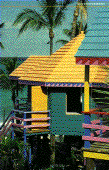Tegucigalpa has almost 800,000 people, six daily
newspapers, no railroad, and wherever you go there's the sound of
birds. Nearly 1,000 of the world's bird species live in or migrate
through Honduras. Birds hang in the trees. Think of apple trees with
birds instead of fruit.
The city is divided by the Choluteca River. I was warned that the
Comayaguela side was "dangerous" and "industrial" and not to go there.
But a drive through it was mesmerizing if only to see what industrial
means in a country whose main product is bananas. Concrete buildings
one story high are painted sherbert colors. You
can get your shoes resoled and your spokes rewelded. Pig parts are the
street food of choice.
Not one red lempira (the currency named after a 16th-century Lenca chief) has gone into glitz. There is no Tegucigalpa snow globe at the airport. There's almost no airport at the airport. And that's the draw: you can see Tegucigalpa the way it really is. Women carry baskets on their heads. Calla lillies grow like daisies. Clothes get washed by hand. A boutique called Lelic sells Chanel and fresh eggs. Old yellow school buses never die---they wind up in Tegucigalpa where they get painted turquoise and purple. This could be the last unmarketed capital in the world.


